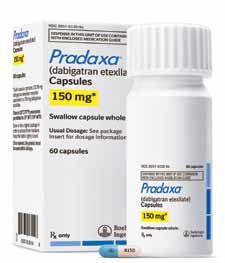Boehringer Ingelheim Pharmaceuticals' Pradaxa
Pradaxa (dabigatran etexilate) is the first oral direct thrombin inhibitor to be approved by the FDA.
Pradaxa (dabigatran etexilate) is the first oral direct thrombin inhibitor to be approved by the FDA.

Pradaxa (dabigatran etexilate), developed by Boehringer Ingelheim Pharmaceuticals, is the first oral direct thrombin inhibitor to be approved by the FDA. Dabigatran was approved on October 19, 2010, to reduce incidence of stroke and systemic embolism in patients diagnosed with nonvalvular atrial fibrillation (AF).1 AF is characterized by an irregular heartbeat in the upper chambers; this increases the likelihood of blood pooling, and eventually, clot formation. It is the most common heart arrhythmia, as well as the most common cause of ischemic stroke, accounting for 6% to 24% of all cases.1,2
Vitamin K antagonists, such as warfarin, are usually the standard treatment for patients with AF. Due to interactions with dietary food and other drugs, however, patients receiving warfarin require frequent laboratory monitoring. As a result, many patients become nonadherent or receive inadequate therapy, thus leaving a window open for therapies with better outcomes.1,3
Pharmacology/ Pharmacokinetics
Dabigatran etexilate is a competitive, direct, reversible inhibitor of thrombin (or coagulation factor IIa), an enzyme in the coagulation cascade.4,5 Thrombin converts soluble fibrinogen to insoluble fibrin and activates coagulation factor XI as a positive feedback mechanism. By inhibiting thrombin activity, dabigatran prevents development of a thrombus as well as thrombin-induced platelet aggregation.4,5
Dabigatran etexilate is a prodrug that is quickly converted to the active form dabigatran with peak concentration occurring approximately 1 hour after oral administration. 4 Dabigatran has a half-life of 12 to 17 hours, and about 80% of the drug is cleared renally. Dabigatran is not affected by cytochrome P450 enzymes. Clinical dosing information for patients with a creatinine clearance (CrCl) <15 mL/min and dialysis information are currently not available.5
Clinical Trials
The efficacy and safety of Pradaxa was evaluated in the Randomized Evaluation of Long-term Anticoagulation Therapy trial.3,4 The noninferiority, phase 3, multicenter, international trial enrolled 18,113 subjects with documented AF randomized to receive 1 of the following: blind dabigatran 110 or 150 mg twice a day, or unblind warfarin dose adjusted to an international normalized ratio (INR) of 2 to 3. All outcomes were evaluated in a blind form. The trial was designed to demonstrate at least 1 dose of dabigatran as noninferior to warfarin for reducing the risk of stroke in patients with nonvalvular AF and systemic embolism.
Patients taking dabigatran 110 mg twice daily and those taking warfarin had the same rates of stroke and embolism.4 In addition, patients taking dabigatran 150 mg twice daily had a lower rate of stroke and embolism compared with those taking warfarin. The most common adverse events leading to treatment discontinuation with Pradaxa (21%) and warfarin (16%) were gastrointestinal (GI).5 These GI events included bleeding, nausea, dyspepsia, upper abdominal pain, and diarrhea (Pradaxa 35% vs warfarin 24%).5 The risk of any type of bleed was similar between Pradaxa 150 mg and warfarin.
Dosing and Precautions
The recommended starting dose for patients with renal function >30 mL/min is 150 mg twice a day. Dose adjustment to 75 mg twice a day is recommended for patients with CrCl 15 to 30 mL/min.5 Patients may be converted from warfarin to Pradaxa when the INR is below 2. When converting from Pradaxa to warfarin, the start time of warfarin and discontinuation of Pradaxa is dependent upon CrCl. Pradaxa should be discontinued before any invasive or surgical procedure due to increased risk of bleeding, but it should be noted that discontinuation may lead to an increased risk of stroke.
Patients should be counseled not to open, crush, or chew the capsules, as this increases bioavailability (75%) of dabigatran. Pradaxa may be taken with or without food. Because Pradaxa is a substrate of the efflux transporter permeability P-glycoprotein (P-gp), any medications that induce P-gp (such as rifampin) or that inhibit P-gp (eg, ketoconazole, verapamil, amiodarone, quinidine, clarithromycin) should be reviewed with the provider.5 PT
Both Ms. Belisle and Dr. Patel are pharmacists at Brigham and Women’s Hospital, Boston, Massachusetts. Brendan Whooley is a third-year PharmD candidate from Northeastern University School of Pharmacy currently on clinical cooperative rotation in the Investigational Drug Service at Brigham and Women’s Hospital, Boston, Massachusetts.

